Analyzing Food Production, Service Methods & Menu Planning -Hotel Op
VerifiedAdded on 2023/06/15
|10
|3281
|439
Report
AI Summary
This report provides a comprehensive analysis of hospitality operations, focusing on food production systems, food and beverage service methods, menu planning considerations, and sustainable menu planning within the context of a hotel setting, specifically referencing Shangri-La. It critically examines conventional, continuous flow, centralized, and assembly kitchen food production systems, highlighting their advantages and disadvantages. Furthermore, it explores various food and beverage service methods such as table service and buffet service, detailing their implementation and suitability for different occasions. The report also delves into the key considerations and constraints in menu planning, including location, customer profile, cost factors, space and equipment limitations, time considerations, seasonal aspects, balance of menu items, and staff skills. Finally, it identifies and analyzes sustainable menu planning considerations, emphasizing the importance of safe and healthy food choices for both humans and the environment, and highlighting the potential cost savings associated with sustainable practices.
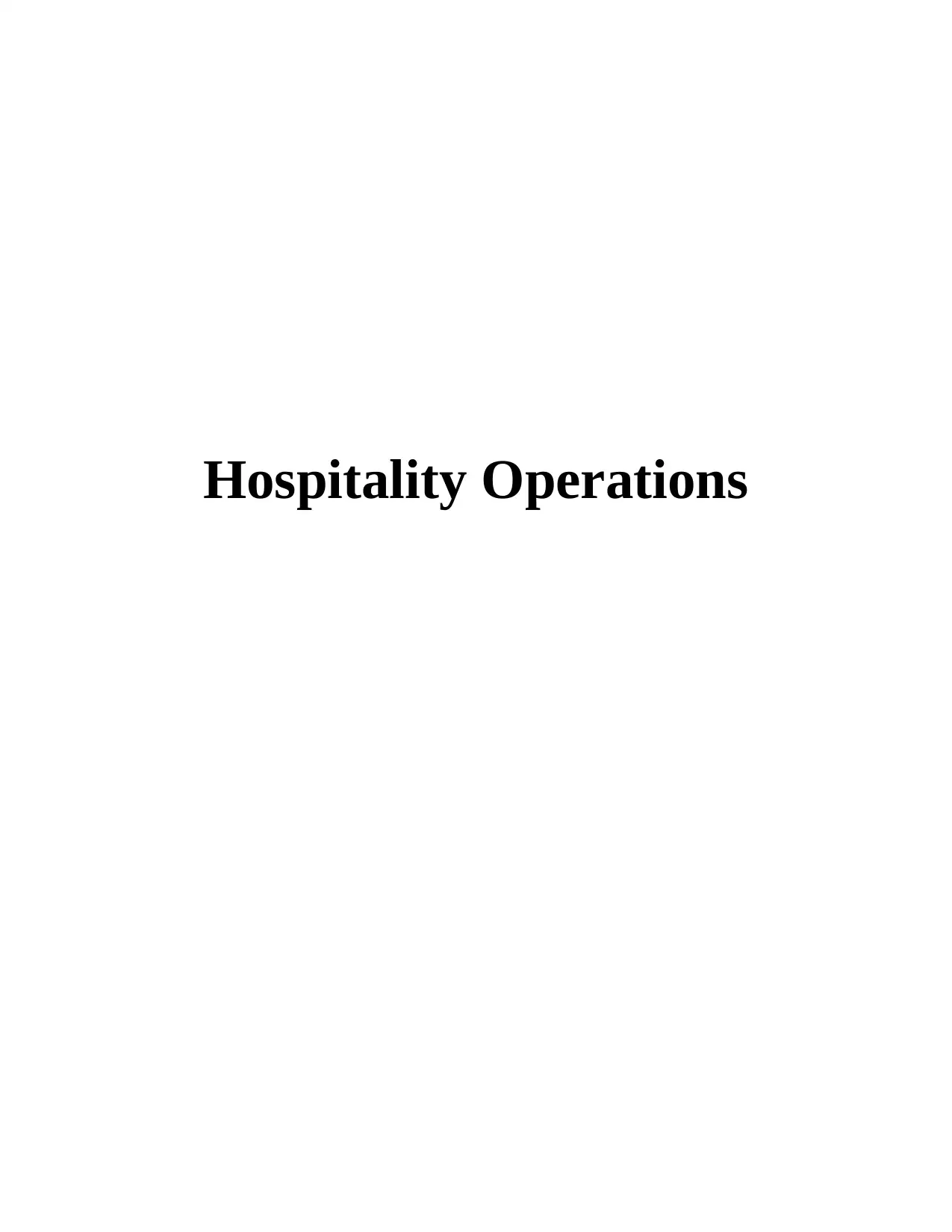
Hospitality Operations
Paraphrase This Document
Need a fresh take? Get an instant paraphrase of this document with our AI Paraphraser
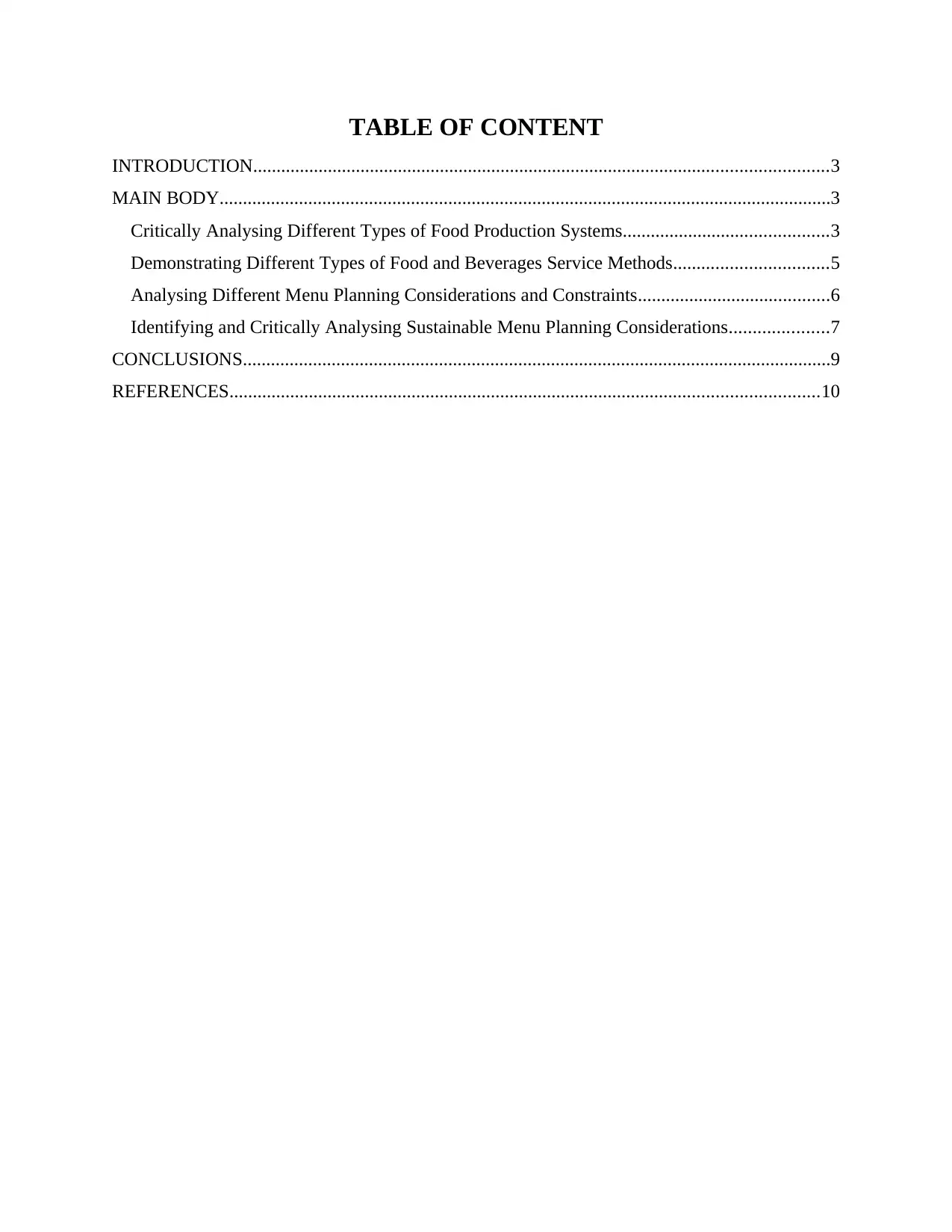
TABLE OF CONTENT
INTRODUCTION...........................................................................................................................3
MAIN BODY...................................................................................................................................3
Critically Analysing Different Types of Food Production Systems............................................3
Demonstrating Different Types of Food and Beverages Service Methods.................................5
Analysing Different Menu Planning Considerations and Constraints.........................................6
Identifying and Critically Analysing Sustainable Menu Planning Considerations.....................7
CONCLUSIONS..............................................................................................................................9
REFERENCES..............................................................................................................................10
INTRODUCTION...........................................................................................................................3
MAIN BODY...................................................................................................................................3
Critically Analysing Different Types of Food Production Systems............................................3
Demonstrating Different Types of Food and Beverages Service Methods.................................5
Analysing Different Menu Planning Considerations and Constraints.........................................6
Identifying and Critically Analysing Sustainable Menu Planning Considerations.....................7
CONCLUSIONS..............................................................................................................................9
REFERENCES..............................................................................................................................10
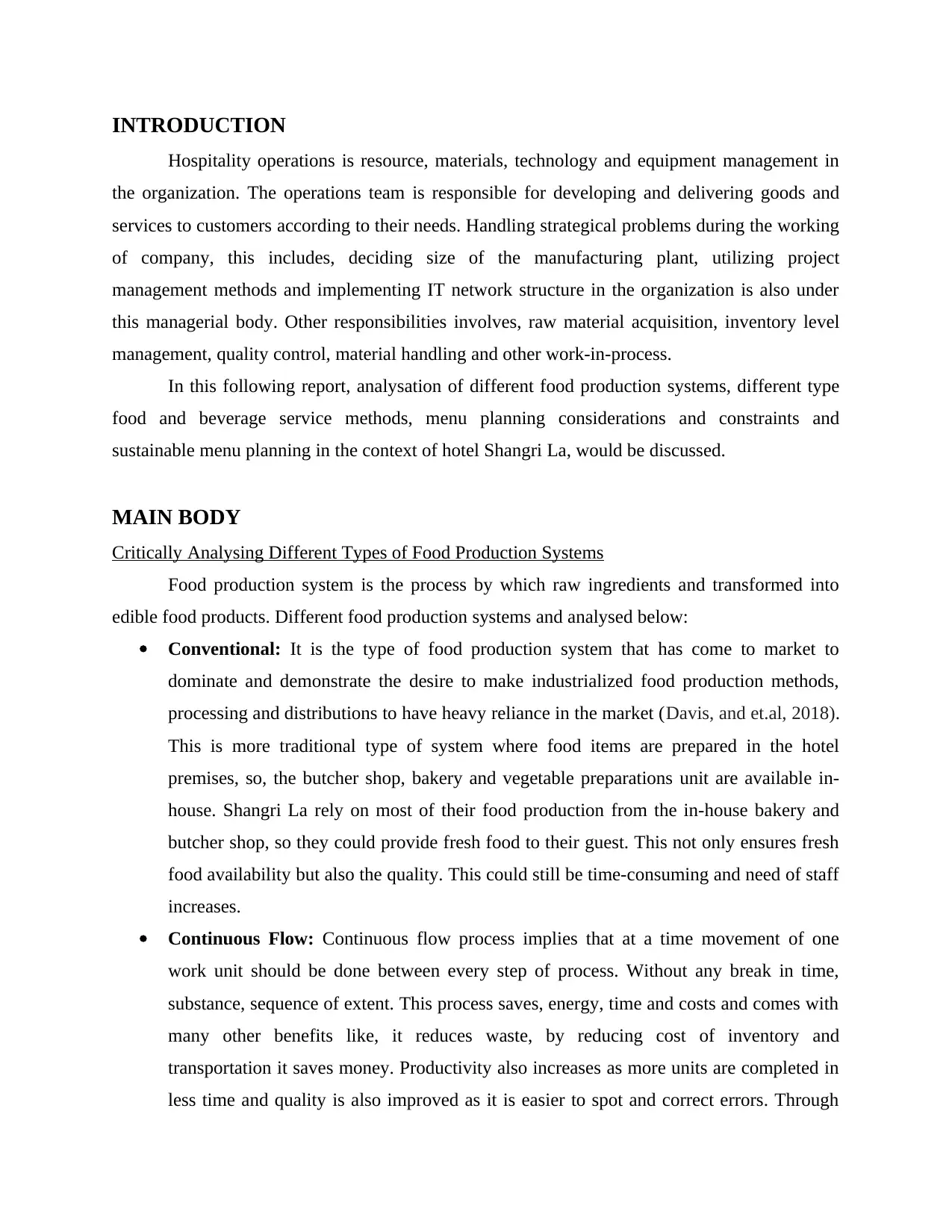
INTRODUCTION
Hospitality operations is resource, materials, technology and equipment management in
the organization. The operations team is responsible for developing and delivering goods and
services to customers according to their needs. Handling strategical problems during the working
of company, this includes, deciding size of the manufacturing plant, utilizing project
management methods and implementing IT network structure in the organization is also under
this managerial body. Other responsibilities involves, raw material acquisition, inventory level
management, quality control, material handling and other work-in-process.
In this following report, analysation of different food production systems, different type
food and beverage service methods, menu planning considerations and constraints and
sustainable menu planning in the context of hotel Shangri La, would be discussed.
MAIN BODY
Critically Analysing Different Types of Food Production Systems
Food production system is the process by which raw ingredients and transformed into
edible food products. Different food production systems and analysed below:
Conventional: It is the type of food production system that has come to market to
dominate and demonstrate the desire to make industrialized food production methods,
processing and distributions to have heavy reliance in the market (Davis, and et.al, 2018).
This is more traditional type of system where food items are prepared in the hotel
premises, so, the butcher shop, bakery and vegetable preparations unit are available in-
house. Shangri La rely on most of their food production from the in-house bakery and
butcher shop, so they could provide fresh food to their guest. This not only ensures fresh
food availability but also the quality. This could still be time-consuming and need of staff
increases.
Continuous Flow: Continuous flow process implies that at a time movement of one
work unit should be done between every step of process. Without any break in time,
substance, sequence of extent. This process saves, energy, time and costs and comes with
many other benefits like, it reduces waste, by reducing cost of inventory and
transportation it saves money. Productivity also increases as more units are completed in
less time and quality is also improved as it is easier to spot and correct errors. Through
Hospitality operations is resource, materials, technology and equipment management in
the organization. The operations team is responsible for developing and delivering goods and
services to customers according to their needs. Handling strategical problems during the working
of company, this includes, deciding size of the manufacturing plant, utilizing project
management methods and implementing IT network structure in the organization is also under
this managerial body. Other responsibilities involves, raw material acquisition, inventory level
management, quality control, material handling and other work-in-process.
In this following report, analysation of different food production systems, different type
food and beverage service methods, menu planning considerations and constraints and
sustainable menu planning in the context of hotel Shangri La, would be discussed.
MAIN BODY
Critically Analysing Different Types of Food Production Systems
Food production system is the process by which raw ingredients and transformed into
edible food products. Different food production systems and analysed below:
Conventional: It is the type of food production system that has come to market to
dominate and demonstrate the desire to make industrialized food production methods,
processing and distributions to have heavy reliance in the market (Davis, and et.al, 2018).
This is more traditional type of system where food items are prepared in the hotel
premises, so, the butcher shop, bakery and vegetable preparations unit are available in-
house. Shangri La rely on most of their food production from the in-house bakery and
butcher shop, so they could provide fresh food to their guest. This not only ensures fresh
food availability but also the quality. This could still be time-consuming and need of staff
increases.
Continuous Flow: Continuous flow process implies that at a time movement of one
work unit should be done between every step of process. Without any break in time,
substance, sequence of extent. This process saves, energy, time and costs and comes with
many other benefits like, it reduces waste, by reducing cost of inventory and
transportation it saves money. Productivity also increases as more units are completed in
less time and quality is also improved as it is easier to spot and correct errors. Through
⊘ This is a preview!⊘
Do you want full access?
Subscribe today to unlock all pages.

Trusted by 1+ million students worldwide
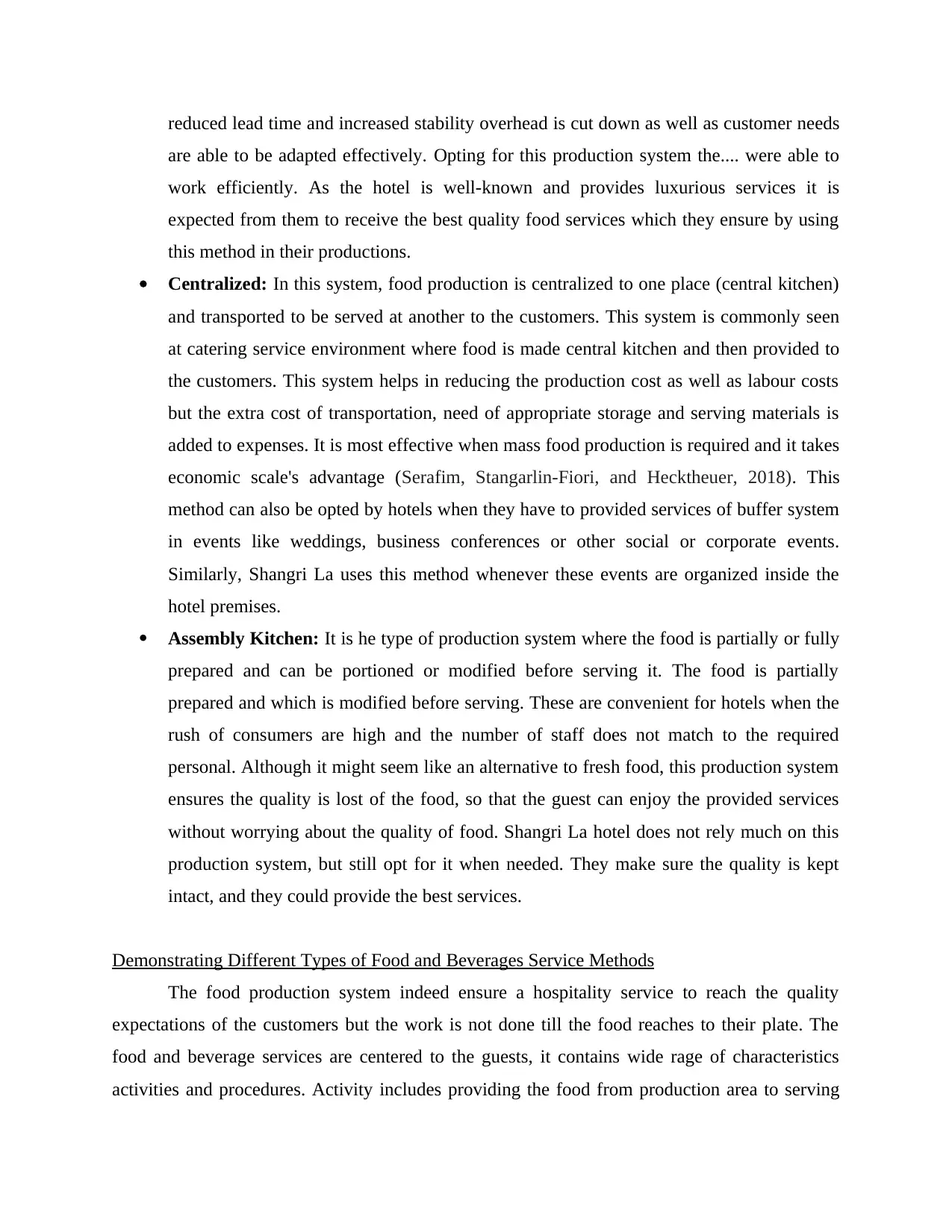
reduced lead time and increased stability overhead is cut down as well as customer needs
are able to be adapted effectively. Opting for this production system the.... were able to
work efficiently. As the hotel is well-known and provides luxurious services it is
expected from them to receive the best quality food services which they ensure by using
this method in their productions.
Centralized: In this system, food production is centralized to one place (central kitchen)
and transported to be served at another to the customers. This system is commonly seen
at catering service environment where food is made central kitchen and then provided to
the customers. This system helps in reducing the production cost as well as labour costs
but the extra cost of transportation, need of appropriate storage and serving materials is
added to expenses. It is most effective when mass food production is required and it takes
economic scale's advantage (Serafim, Stangarlin‐Fiori, and Hecktheuer, 2018). This
method can also be opted by hotels when they have to provided services of buffer system
in events like weddings, business conferences or other social or corporate events.
Similarly, Shangri La uses this method whenever these events are organized inside the
hotel premises.
Assembly Kitchen: It is he type of production system where the food is partially or fully
prepared and can be portioned or modified before serving it. The food is partially
prepared and which is modified before serving. These are convenient for hotels when the
rush of consumers are high and the number of staff does not match to the required
personal. Although it might seem like an alternative to fresh food, this production system
ensures the quality is lost of the food, so that the guest can enjoy the provided services
without worrying about the quality of food. Shangri La hotel does not rely much on this
production system, but still opt for it when needed. They make sure the quality is kept
intact, and they could provide the best services.
Demonstrating Different Types of Food and Beverages Service Methods
The food production system indeed ensure a hospitality service to reach the quality
expectations of the customers but the work is not done till the food reaches to their plate. The
food and beverage services are centered to the guests, it contains wide rage of characteristics
activities and procedures. Activity includes providing the food from production area to serving
are able to be adapted effectively. Opting for this production system the.... were able to
work efficiently. As the hotel is well-known and provides luxurious services it is
expected from them to receive the best quality food services which they ensure by using
this method in their productions.
Centralized: In this system, food production is centralized to one place (central kitchen)
and transported to be served at another to the customers. This system is commonly seen
at catering service environment where food is made central kitchen and then provided to
the customers. This system helps in reducing the production cost as well as labour costs
but the extra cost of transportation, need of appropriate storage and serving materials is
added to expenses. It is most effective when mass food production is required and it takes
economic scale's advantage (Serafim, Stangarlin‐Fiori, and Hecktheuer, 2018). This
method can also be opted by hotels when they have to provided services of buffer system
in events like weddings, business conferences or other social or corporate events.
Similarly, Shangri La uses this method whenever these events are organized inside the
hotel premises.
Assembly Kitchen: It is he type of production system where the food is partially or fully
prepared and can be portioned or modified before serving it. The food is partially
prepared and which is modified before serving. These are convenient for hotels when the
rush of consumers are high and the number of staff does not match to the required
personal. Although it might seem like an alternative to fresh food, this production system
ensures the quality is lost of the food, so that the guest can enjoy the provided services
without worrying about the quality of food. Shangri La hotel does not rely much on this
production system, but still opt for it when needed. They make sure the quality is kept
intact, and they could provide the best services.
Demonstrating Different Types of Food and Beverages Service Methods
The food production system indeed ensure a hospitality service to reach the quality
expectations of the customers but the work is not done till the food reaches to their plate. The
food and beverage services are centered to the guests, it contains wide rage of characteristics
activities and procedures. Activity includes providing the food from production area to serving
Paraphrase This Document
Need a fresh take? Get an instant paraphrase of this document with our AI Paraphraser
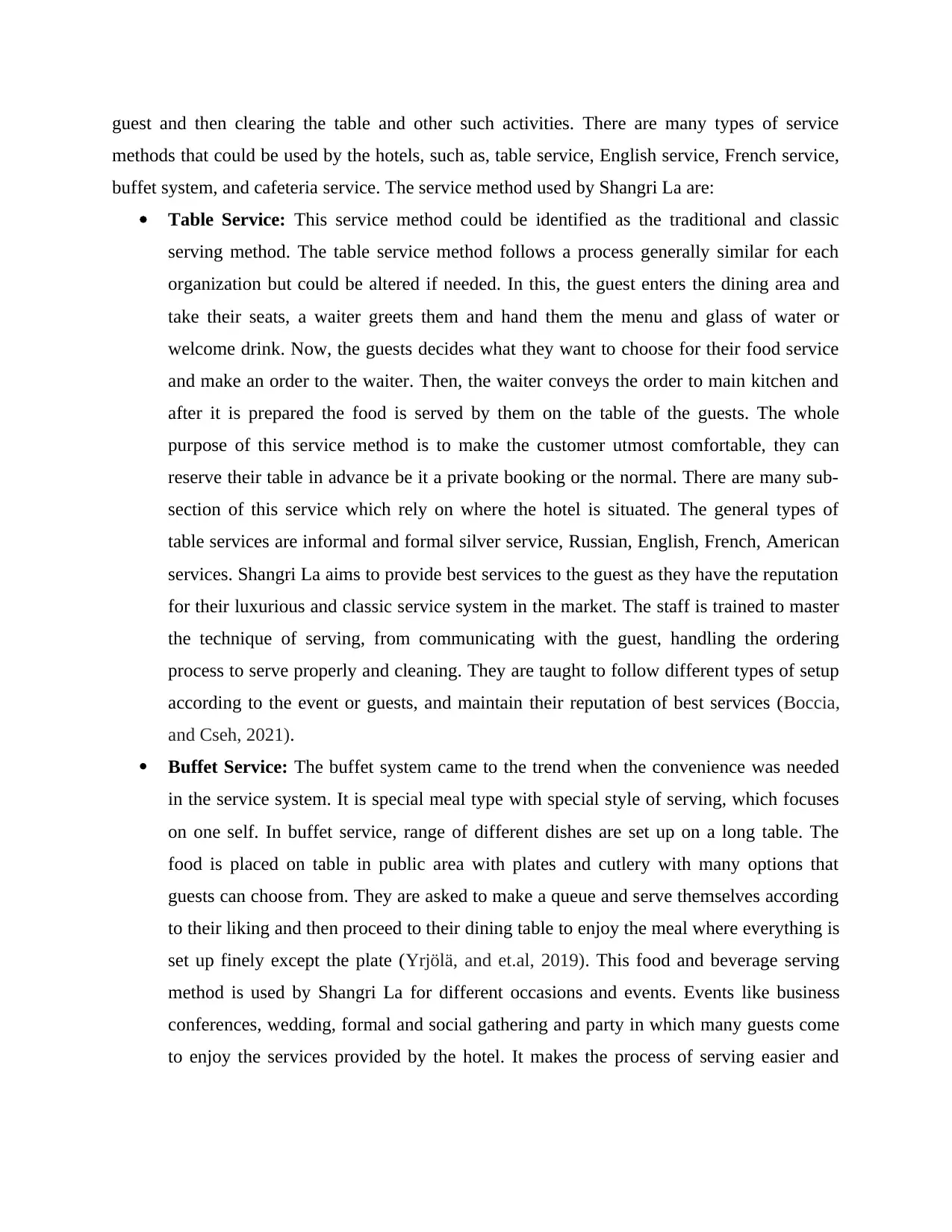
guest and then clearing the table and other such activities. There are many types of service
methods that could be used by the hotels, such as, table service, English service, French service,
buffet system, and cafeteria service. The service method used by Shangri La are:
Table Service: This service method could be identified as the traditional and classic
serving method. The table service method follows a process generally similar for each
organization but could be altered if needed. In this, the guest enters the dining area and
take their seats, a waiter greets them and hand them the menu and glass of water or
welcome drink. Now, the guests decides what they want to choose for their food service
and make an order to the waiter. Then, the waiter conveys the order to main kitchen and
after it is prepared the food is served by them on the table of the guests. The whole
purpose of this service method is to make the customer utmost comfortable, they can
reserve their table in advance be it a private booking or the normal. There are many sub-
section of this service which rely on where the hotel is situated. The general types of
table services are informal and formal silver service, Russian, English, French, American
services. Shangri La aims to provide best services to the guest as they have the reputation
for their luxurious and classic service system in the market. The staff is trained to master
the technique of serving, from communicating with the guest, handling the ordering
process to serve properly and cleaning. They are taught to follow different types of setup
according to the event or guests, and maintain their reputation of best services (Boccia,
and Cseh, 2021).
Buffet Service: The buffet system came to the trend when the convenience was needed
in the service system. It is special meal type with special style of serving, which focuses
on one self. In buffet service, range of different dishes are set up on a long table. The
food is placed on table in public area with plates and cutlery with many options that
guests can choose from. They are asked to make a queue and serve themselves according
to their liking and then proceed to their dining table to enjoy the meal where everything is
set up finely except the plate (Yrjölä, and et.al, 2019). This food and beverage serving
method is used by Shangri La for different occasions and events. Events like business
conferences, wedding, formal and social gathering and party in which many guests come
to enjoy the services provided by the hotel. It makes the process of serving easier and
methods that could be used by the hotels, such as, table service, English service, French service,
buffet system, and cafeteria service. The service method used by Shangri La are:
Table Service: This service method could be identified as the traditional and classic
serving method. The table service method follows a process generally similar for each
organization but could be altered if needed. In this, the guest enters the dining area and
take their seats, a waiter greets them and hand them the menu and glass of water or
welcome drink. Now, the guests decides what they want to choose for their food service
and make an order to the waiter. Then, the waiter conveys the order to main kitchen and
after it is prepared the food is served by them on the table of the guests. The whole
purpose of this service method is to make the customer utmost comfortable, they can
reserve their table in advance be it a private booking or the normal. There are many sub-
section of this service which rely on where the hotel is situated. The general types of
table services are informal and formal silver service, Russian, English, French, American
services. Shangri La aims to provide best services to the guest as they have the reputation
for their luxurious and classic service system in the market. The staff is trained to master
the technique of serving, from communicating with the guest, handling the ordering
process to serve properly and cleaning. They are taught to follow different types of setup
according to the event or guests, and maintain their reputation of best services (Boccia,
and Cseh, 2021).
Buffet Service: The buffet system came to the trend when the convenience was needed
in the service system. It is special meal type with special style of serving, which focuses
on one self. In buffet service, range of different dishes are set up on a long table. The
food is placed on table in public area with plates and cutlery with many options that
guests can choose from. They are asked to make a queue and serve themselves according
to their liking and then proceed to their dining table to enjoy the meal where everything is
set up finely except the plate (Yrjölä, and et.al, 2019). This food and beverage serving
method is used by Shangri La for different occasions and events. Events like business
conferences, wedding, formal and social gathering and party in which many guests come
to enjoy the services provided by the hotel. It makes the process of serving easier and
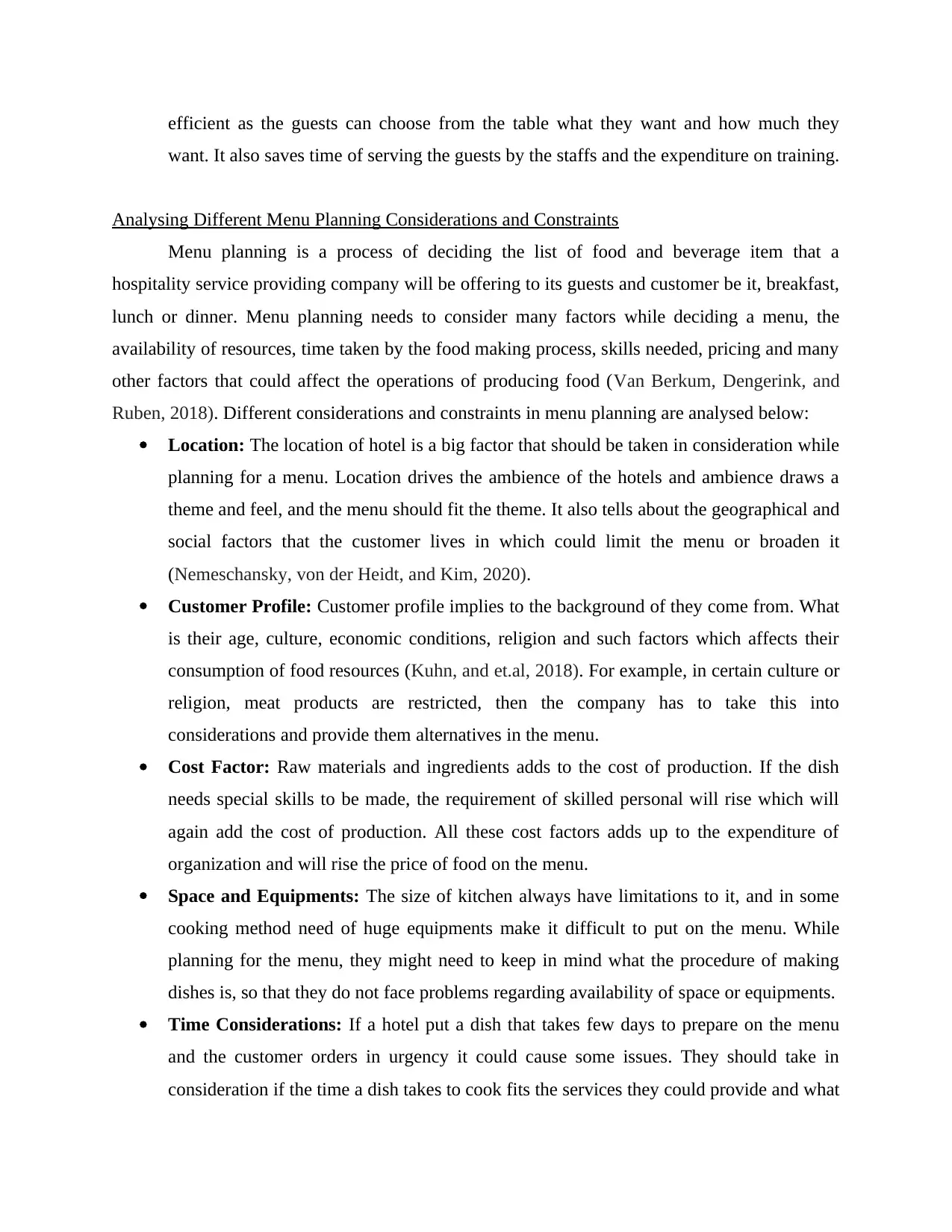
efficient as the guests can choose from the table what they want and how much they
want. It also saves time of serving the guests by the staffs and the expenditure on training.
Analysing Different Menu Planning Considerations and Constraints
Menu planning is a process of deciding the list of food and beverage item that a
hospitality service providing company will be offering to its guests and customer be it, breakfast,
lunch or dinner. Menu planning needs to consider many factors while deciding a menu, the
availability of resources, time taken by the food making process, skills needed, pricing and many
other factors that could affect the operations of producing food (Van Berkum, Dengerink, and
Ruben, 2018). Different considerations and constraints in menu planning are analysed below:
Location: The location of hotel is a big factor that should be taken in consideration while
planning for a menu. Location drives the ambience of the hotels and ambience draws a
theme and feel, and the menu should fit the theme. It also tells about the geographical and
social factors that the customer lives in which could limit the menu or broaden it
(Nemeschansky, von der Heidt, and Kim, 2020).
Customer Profile: Customer profile implies to the background of they come from. What
is their age, culture, economic conditions, religion and such factors which affects their
consumption of food resources (Kuhn, and et.al, 2018). For example, in certain culture or
religion, meat products are restricted, then the company has to take this into
considerations and provide them alternatives in the menu.
Cost Factor: Raw materials and ingredients adds to the cost of production. If the dish
needs special skills to be made, the requirement of skilled personal will rise which will
again add the cost of production. All these cost factors adds up to the expenditure of
organization and will rise the price of food on the menu.
Space and Equipments: The size of kitchen always have limitations to it, and in some
cooking method need of huge equipments make it difficult to put on the menu. While
planning for the menu, they might need to keep in mind what the procedure of making
dishes is, so that they do not face problems regarding availability of space or equipments.
Time Considerations: If a hotel put a dish that takes few days to prepare on the menu
and the customer orders in urgency it could cause some issues. They should take in
consideration if the time a dish takes to cook fits the services they could provide and what
want. It also saves time of serving the guests by the staffs and the expenditure on training.
Analysing Different Menu Planning Considerations and Constraints
Menu planning is a process of deciding the list of food and beverage item that a
hospitality service providing company will be offering to its guests and customer be it, breakfast,
lunch or dinner. Menu planning needs to consider many factors while deciding a menu, the
availability of resources, time taken by the food making process, skills needed, pricing and many
other factors that could affect the operations of producing food (Van Berkum, Dengerink, and
Ruben, 2018). Different considerations and constraints in menu planning are analysed below:
Location: The location of hotel is a big factor that should be taken in consideration while
planning for a menu. Location drives the ambience of the hotels and ambience draws a
theme and feel, and the menu should fit the theme. It also tells about the geographical and
social factors that the customer lives in which could limit the menu or broaden it
(Nemeschansky, von der Heidt, and Kim, 2020).
Customer Profile: Customer profile implies to the background of they come from. What
is their age, culture, economic conditions, religion and such factors which affects their
consumption of food resources (Kuhn, and et.al, 2018). For example, in certain culture or
religion, meat products are restricted, then the company has to take this into
considerations and provide them alternatives in the menu.
Cost Factor: Raw materials and ingredients adds to the cost of production. If the dish
needs special skills to be made, the requirement of skilled personal will rise which will
again add the cost of production. All these cost factors adds up to the expenditure of
organization and will rise the price of food on the menu.
Space and Equipments: The size of kitchen always have limitations to it, and in some
cooking method need of huge equipments make it difficult to put on the menu. While
planning for the menu, they might need to keep in mind what the procedure of making
dishes is, so that they do not face problems regarding availability of space or equipments.
Time Considerations: If a hotel put a dish that takes few days to prepare on the menu
and the customer orders in urgency it could cause some issues. They should take in
consideration if the time a dish takes to cook fits the services they could provide and what
⊘ This is a preview!⊘
Do you want full access?
Subscribe today to unlock all pages.

Trusted by 1+ million students worldwide
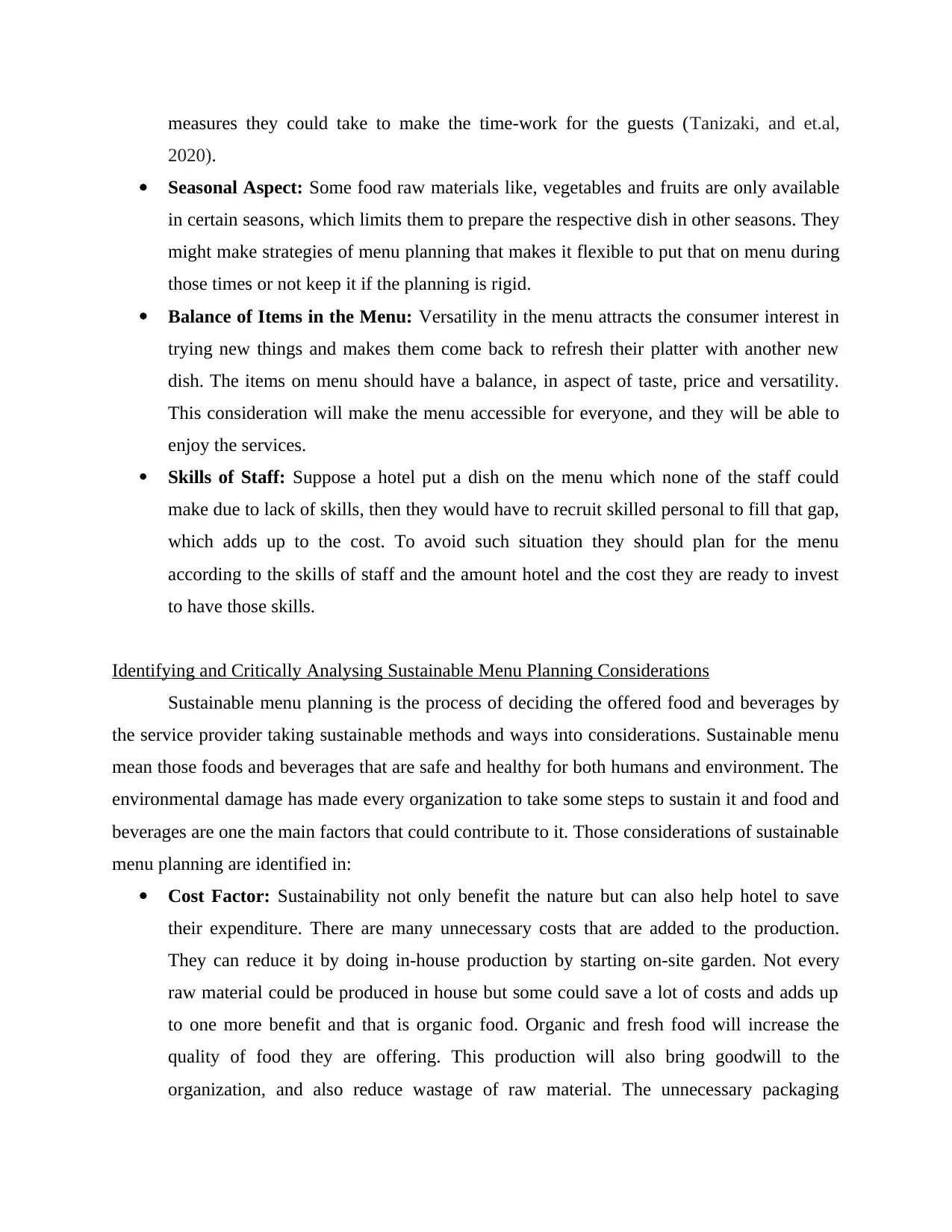
measures they could take to make the time-work for the guests (Tanizaki, and et.al,
2020).
Seasonal Aspect: Some food raw materials like, vegetables and fruits are only available
in certain seasons, which limits them to prepare the respective dish in other seasons. They
might make strategies of menu planning that makes it flexible to put that on menu during
those times or not keep it if the planning is rigid.
Balance of Items in the Menu: Versatility in the menu attracts the consumer interest in
trying new things and makes them come back to refresh their platter with another new
dish. The items on menu should have a balance, in aspect of taste, price and versatility.
This consideration will make the menu accessible for everyone, and they will be able to
enjoy the services.
Skills of Staff: Suppose a hotel put a dish on the menu which none of the staff could
make due to lack of skills, then they would have to recruit skilled personal to fill that gap,
which adds up to the cost. To avoid such situation they should plan for the menu
according to the skills of staff and the amount hotel and the cost they are ready to invest
to have those skills.
Identifying and Critically Analysing Sustainable Menu Planning Considerations
Sustainable menu planning is the process of deciding the offered food and beverages by
the service provider taking sustainable methods and ways into considerations. Sustainable menu
mean those foods and beverages that are safe and healthy for both humans and environment. The
environmental damage has made every organization to take some steps to sustain it and food and
beverages are one the main factors that could contribute to it. Those considerations of sustainable
menu planning are identified in:
Cost Factor: Sustainability not only benefit the nature but can also help hotel to save
their expenditure. There are many unnecessary costs that are added to the production.
They can reduce it by doing in-house production by starting on-site garden. Not every
raw material could be produced in house but some could save a lot of costs and adds up
to one more benefit and that is organic food. Organic and fresh food will increase the
quality of food they are offering. This production will also bring goodwill to the
organization, and also reduce wastage of raw material. The unnecessary packaging
2020).
Seasonal Aspect: Some food raw materials like, vegetables and fruits are only available
in certain seasons, which limits them to prepare the respective dish in other seasons. They
might make strategies of menu planning that makes it flexible to put that on menu during
those times or not keep it if the planning is rigid.
Balance of Items in the Menu: Versatility in the menu attracts the consumer interest in
trying new things and makes them come back to refresh their platter with another new
dish. The items on menu should have a balance, in aspect of taste, price and versatility.
This consideration will make the menu accessible for everyone, and they will be able to
enjoy the services.
Skills of Staff: Suppose a hotel put a dish on the menu which none of the staff could
make due to lack of skills, then they would have to recruit skilled personal to fill that gap,
which adds up to the cost. To avoid such situation they should plan for the menu
according to the skills of staff and the amount hotel and the cost they are ready to invest
to have those skills.
Identifying and Critically Analysing Sustainable Menu Planning Considerations
Sustainable menu planning is the process of deciding the offered food and beverages by
the service provider taking sustainable methods and ways into considerations. Sustainable menu
mean those foods and beverages that are safe and healthy for both humans and environment. The
environmental damage has made every organization to take some steps to sustain it and food and
beverages are one the main factors that could contribute to it. Those considerations of sustainable
menu planning are identified in:
Cost Factor: Sustainability not only benefit the nature but can also help hotel to save
their expenditure. There are many unnecessary costs that are added to the production.
They can reduce it by doing in-house production by starting on-site garden. Not every
raw material could be produced in house but some could save a lot of costs and adds up
to one more benefit and that is organic food. Organic and fresh food will increase the
quality of food they are offering. This production will also bring goodwill to the
organization, and also reduce wastage of raw material. The unnecessary packaging
Paraphrase This Document
Need a fresh take? Get an instant paraphrase of this document with our AI Paraphraser
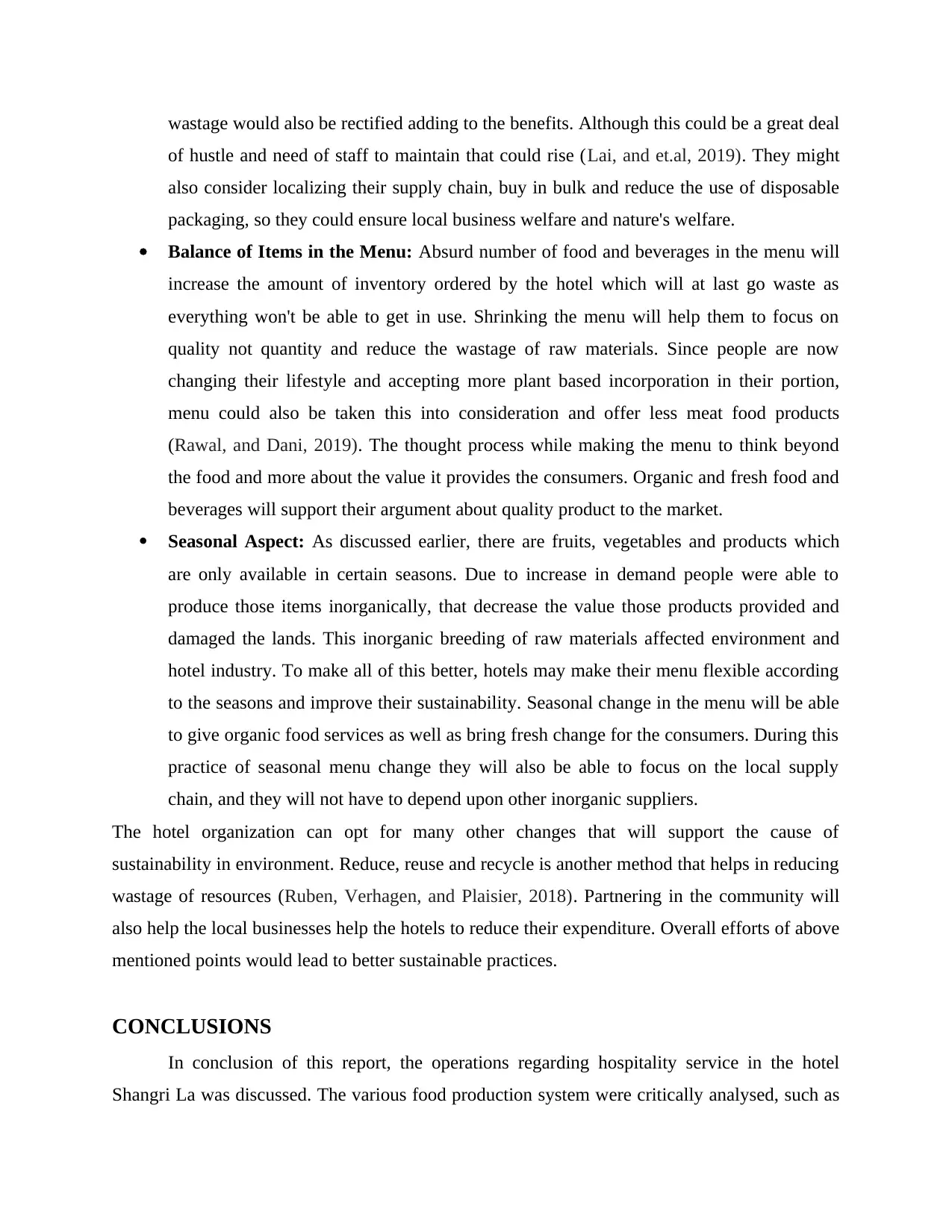
wastage would also be rectified adding to the benefits. Although this could be a great deal
of hustle and need of staff to maintain that could rise (Lai, and et.al, 2019). They might
also consider localizing their supply chain, buy in bulk and reduce the use of disposable
packaging, so they could ensure local business welfare and nature's welfare.
Balance of Items in the Menu: Absurd number of food and beverages in the menu will
increase the amount of inventory ordered by the hotel which will at last go waste as
everything won't be able to get in use. Shrinking the menu will help them to focus on
quality not quantity and reduce the wastage of raw materials. Since people are now
changing their lifestyle and accepting more plant based incorporation in their portion,
menu could also be taken this into consideration and offer less meat food products
(Rawal, and Dani, 2019). The thought process while making the menu to think beyond
the food and more about the value it provides the consumers. Organic and fresh food and
beverages will support their argument about quality product to the market.
Seasonal Aspect: As discussed earlier, there are fruits, vegetables and products which
are only available in certain seasons. Due to increase in demand people were able to
produce those items inorganically, that decrease the value those products provided and
damaged the lands. This inorganic breeding of raw materials affected environment and
hotel industry. To make all of this better, hotels may make their menu flexible according
to the seasons and improve their sustainability. Seasonal change in the menu will be able
to give organic food services as well as bring fresh change for the consumers. During this
practice of seasonal menu change they will also be able to focus on the local supply
chain, and they will not have to depend upon other inorganic suppliers.
The hotel organization can opt for many other changes that will support the cause of
sustainability in environment. Reduce, reuse and recycle is another method that helps in reducing
wastage of resources (Ruben, Verhagen, and Plaisier, 2018). Partnering in the community will
also help the local businesses help the hotels to reduce their expenditure. Overall efforts of above
mentioned points would lead to better sustainable practices.
CONCLUSIONS
In conclusion of this report, the operations regarding hospitality service in the hotel
Shangri La was discussed. The various food production system were critically analysed, such as
of hustle and need of staff to maintain that could rise (Lai, and et.al, 2019). They might
also consider localizing their supply chain, buy in bulk and reduce the use of disposable
packaging, so they could ensure local business welfare and nature's welfare.
Balance of Items in the Menu: Absurd number of food and beverages in the menu will
increase the amount of inventory ordered by the hotel which will at last go waste as
everything won't be able to get in use. Shrinking the menu will help them to focus on
quality not quantity and reduce the wastage of raw materials. Since people are now
changing their lifestyle and accepting more plant based incorporation in their portion,
menu could also be taken this into consideration and offer less meat food products
(Rawal, and Dani, 2019). The thought process while making the menu to think beyond
the food and more about the value it provides the consumers. Organic and fresh food and
beverages will support their argument about quality product to the market.
Seasonal Aspect: As discussed earlier, there are fruits, vegetables and products which
are only available in certain seasons. Due to increase in demand people were able to
produce those items inorganically, that decrease the value those products provided and
damaged the lands. This inorganic breeding of raw materials affected environment and
hotel industry. To make all of this better, hotels may make their menu flexible according
to the seasons and improve their sustainability. Seasonal change in the menu will be able
to give organic food services as well as bring fresh change for the consumers. During this
practice of seasonal menu change they will also be able to focus on the local supply
chain, and they will not have to depend upon other inorganic suppliers.
The hotel organization can opt for many other changes that will support the cause of
sustainability in environment. Reduce, reuse and recycle is another method that helps in reducing
wastage of resources (Ruben, Verhagen, and Plaisier, 2018). Partnering in the community will
also help the local businesses help the hotels to reduce their expenditure. Overall efforts of above
mentioned points would lead to better sustainable practices.
CONCLUSIONS
In conclusion of this report, the operations regarding hospitality service in the hotel
Shangri La was discussed. The various food production system were critically analysed, such as
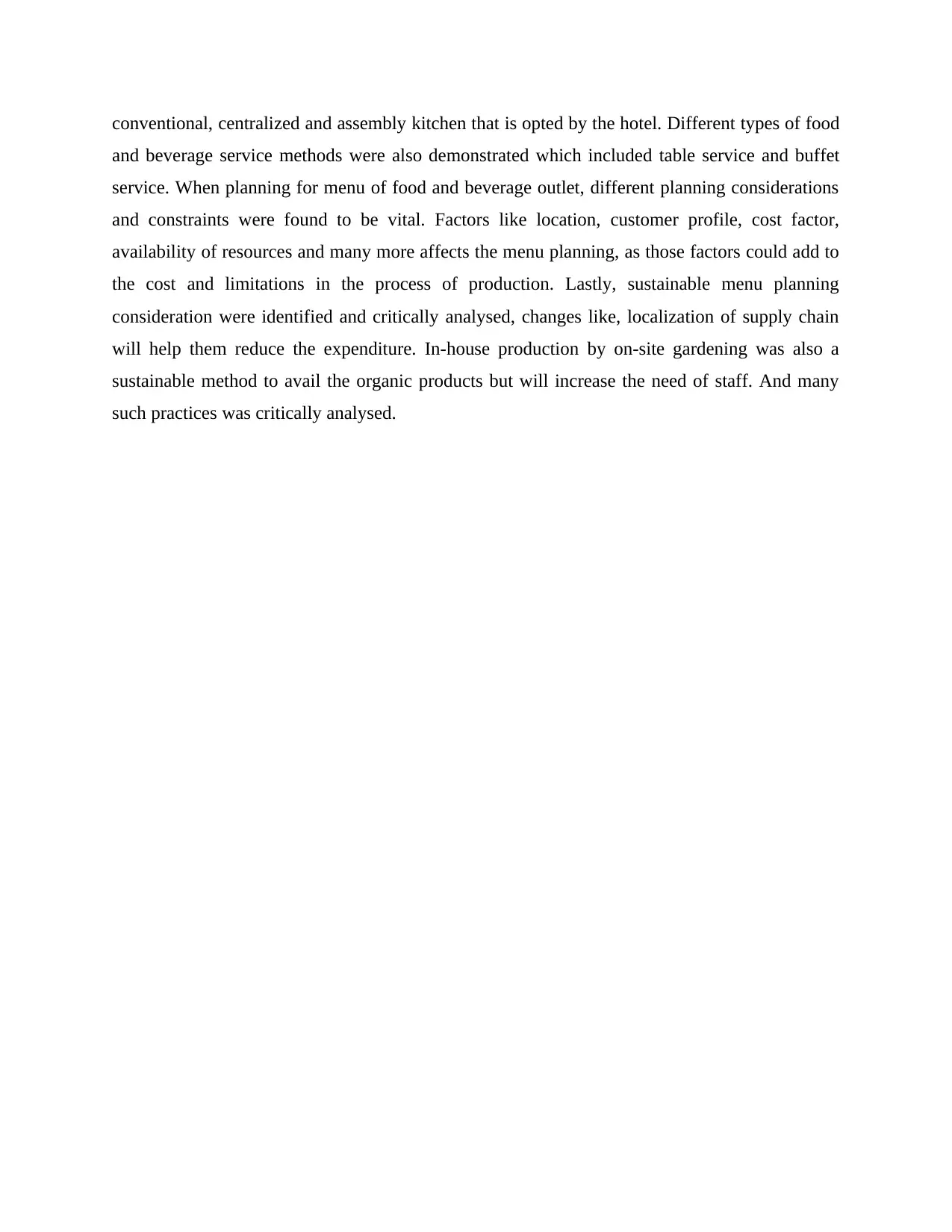
conventional, centralized and assembly kitchen that is opted by the hotel. Different types of food
and beverage service methods were also demonstrated which included table service and buffet
service. When planning for menu of food and beverage outlet, different planning considerations
and constraints were found to be vital. Factors like location, customer profile, cost factor,
availability of resources and many more affects the menu planning, as those factors could add to
the cost and limitations in the process of production. Lastly, sustainable menu planning
consideration were identified and critically analysed, changes like, localization of supply chain
will help them reduce the expenditure. In-house production by on-site gardening was also a
sustainable method to avail the organic products but will increase the need of staff. And many
such practices was critically analysed.
and beverage service methods were also demonstrated which included table service and buffet
service. When planning for menu of food and beverage outlet, different planning considerations
and constraints were found to be vital. Factors like location, customer profile, cost factor,
availability of resources and many more affects the menu planning, as those factors could add to
the cost and limitations in the process of production. Lastly, sustainable menu planning
consideration were identified and critically analysed, changes like, localization of supply chain
will help them reduce the expenditure. In-house production by on-site gardening was also a
sustainable method to avail the organic products but will increase the need of staff. And many
such practices was critically analysed.
⊘ This is a preview!⊘
Do you want full access?
Subscribe today to unlock all pages.

Trusted by 1+ million students worldwide
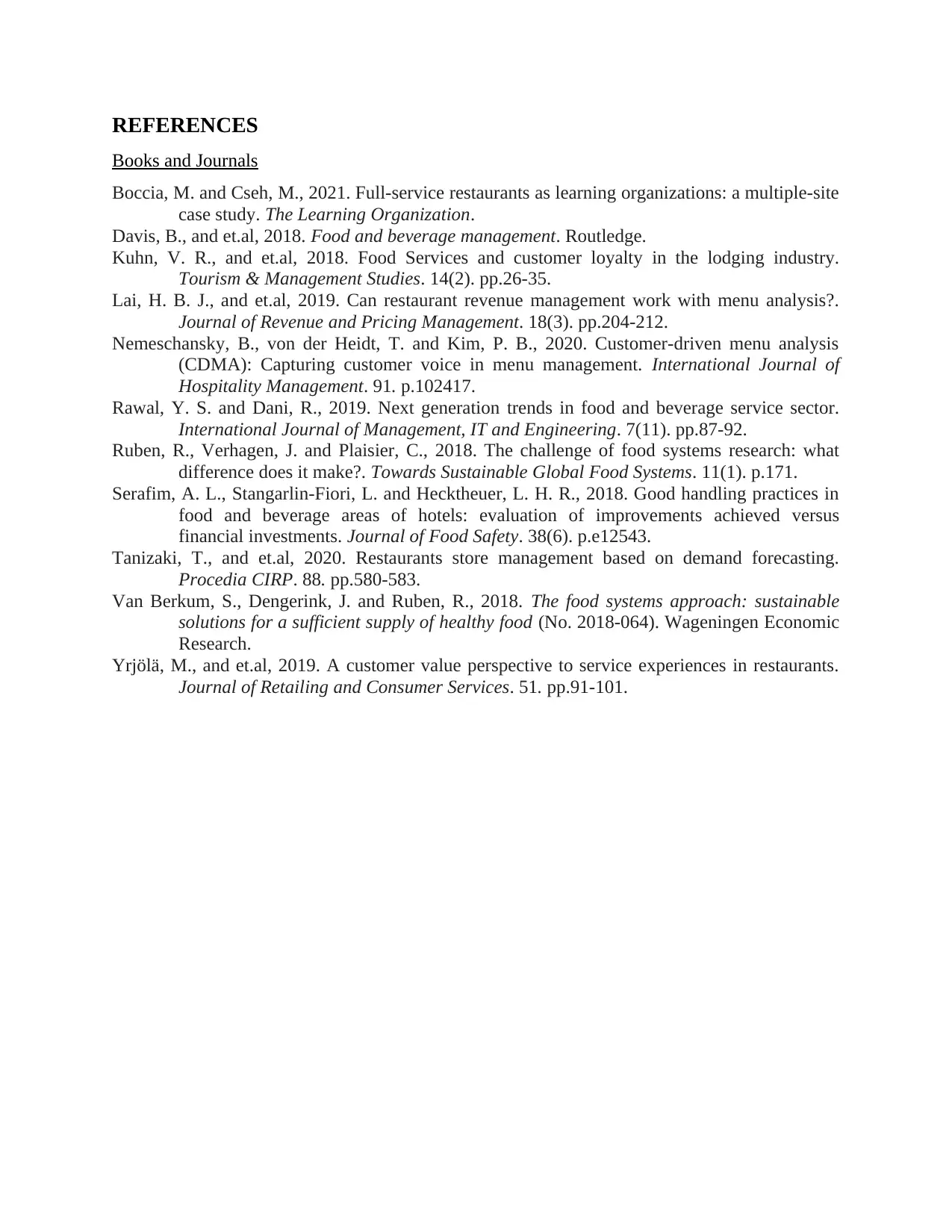
REFERENCES
Books and Journals
Boccia, M. and Cseh, M., 2021. Full-service restaurants as learning organizations: a multiple-site
case study. The Learning Organization.
Davis, B., and et.al, 2018. Food and beverage management. Routledge.
Kuhn, V. R., and et.al, 2018. Food Services and customer loyalty in the lodging industry.
Tourism & Management Studies. 14(2). pp.26-35.
Lai, H. B. J., and et.al, 2019. Can restaurant revenue management work with menu analysis?.
Journal of Revenue and Pricing Management. 18(3). pp.204-212.
Nemeschansky, B., von der Heidt, T. and Kim, P. B., 2020. Customer-driven menu analysis
(CDMA): Capturing customer voice in menu management. International Journal of
Hospitality Management. 91. p.102417.
Rawal, Y. S. and Dani, R., 2019. Next generation trends in food and beverage service sector.
International Journal of Management, IT and Engineering. 7(11). pp.87-92.
Ruben, R., Verhagen, J. and Plaisier, C., 2018. The challenge of food systems research: what
difference does it make?. Towards Sustainable Global Food Systems. 11(1). p.171.
Serafim, A. L., Stangarlin‐Fiori, L. and Hecktheuer, L. H. R., 2018. Good handling practices in
food and beverage areas of hotels: evaluation of improvements achieved versus
financial investments. Journal of Food Safety. 38(6). p.e12543.
Tanizaki, T., and et.al, 2020. Restaurants store management based on demand forecasting.
Procedia CIRP. 88. pp.580-583.
Van Berkum, S., Dengerink, J. and Ruben, R., 2018. The food systems approach: sustainable
solutions for a sufficient supply of healthy food (No. 2018-064). Wageningen Economic
Research.
Yrjölä, M., and et.al, 2019. A customer value perspective to service experiences in restaurants.
Journal of Retailing and Consumer Services. 51. pp.91-101.
Books and Journals
Boccia, M. and Cseh, M., 2021. Full-service restaurants as learning organizations: a multiple-site
case study. The Learning Organization.
Davis, B., and et.al, 2018. Food and beverage management. Routledge.
Kuhn, V. R., and et.al, 2018. Food Services and customer loyalty in the lodging industry.
Tourism & Management Studies. 14(2). pp.26-35.
Lai, H. B. J., and et.al, 2019. Can restaurant revenue management work with menu analysis?.
Journal of Revenue and Pricing Management. 18(3). pp.204-212.
Nemeschansky, B., von der Heidt, T. and Kim, P. B., 2020. Customer-driven menu analysis
(CDMA): Capturing customer voice in menu management. International Journal of
Hospitality Management. 91. p.102417.
Rawal, Y. S. and Dani, R., 2019. Next generation trends in food and beverage service sector.
International Journal of Management, IT and Engineering. 7(11). pp.87-92.
Ruben, R., Verhagen, J. and Plaisier, C., 2018. The challenge of food systems research: what
difference does it make?. Towards Sustainable Global Food Systems. 11(1). p.171.
Serafim, A. L., Stangarlin‐Fiori, L. and Hecktheuer, L. H. R., 2018. Good handling practices in
food and beverage areas of hotels: evaluation of improvements achieved versus
financial investments. Journal of Food Safety. 38(6). p.e12543.
Tanizaki, T., and et.al, 2020. Restaurants store management based on demand forecasting.
Procedia CIRP. 88. pp.580-583.
Van Berkum, S., Dengerink, J. and Ruben, R., 2018. The food systems approach: sustainable
solutions for a sufficient supply of healthy food (No. 2018-064). Wageningen Economic
Research.
Yrjölä, M., and et.al, 2019. A customer value perspective to service experiences in restaurants.
Journal of Retailing and Consumer Services. 51. pp.91-101.
1 out of 10
Related Documents
Your All-in-One AI-Powered Toolkit for Academic Success.
+13062052269
info@desklib.com
Available 24*7 on WhatsApp / Email
![[object Object]](/_next/static/media/star-bottom.7253800d.svg)
Unlock your academic potential
Copyright © 2020–2025 A2Z Services. All Rights Reserved. Developed and managed by ZUCOL.



